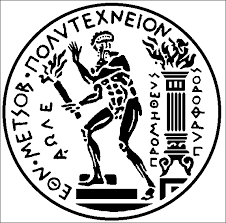245 σ.
(EL)
Αντικείμενο της παρούσας διατριβής είναι η μελέτη προβλημάτων εξαρμώσεων και ρωγμών στα πλαίσια της κλασσικής θεωρίας ελαστικότητας και της θεωρίας τάσεων ζεύγους. Η αλληλεπίδραση ρωγμών και εξαρμώσεων είναι ένα θεμελιώδες πρόβλημα της Μηχανικής των Θραύσεων, εφόσον η αλληλεπίδραση αυτή καθορίζει, σε αρκετές περιπτώσεις, την μακροσκοπική όλκιμη ή ψαθυρή απόκριση του υλικού.
Αρχικά, παρουσιάζεται μία μεθοδολογία ανάλυσης επίπεδων εξαρμώσεων με τη μέθοδο των πεπερασμένων στοιχείων, η οποία βασίζεται σε ένα ανάλογο από την θερμοελαστικότητα και την περιγραφή των εξαρμώσεων μέσω ολοκληρωμάτων τάσεων. Χρησιμοποιώντας την μέθοδο αυτή, εξετάζεται το πρόβλημα της αλληλεπίδρασης μίας ημιάπειρης ρωγμής με επίπεδες εξαρμώσεις. Ο ρυθμός έκλυσης ενέργειας στο άκρο της ρωγμής και η κινούσα δύναμη που ασκείται στην εξάρμωση υπολογίζονται αριθμητικά μέσω συντηρητικών ολοκληρωμάτων της γραμμικής ελαστοστατικής. Για τον έλεγχο της ακρίβειας της προτεινόμενης μεθοδολογίας, επιλύονται προβλήματα με γνωστές αναλυτικές λύσεις ενώ παρέχονται νέα αποτελέσματα σε περιπτώσεις σύνθετων διατάξεων και ανισοτροπικής καταστατικής συμπεριφοράς. Επιπλέον, ενσωματώνεται το μοντέλο μεταβλητού πυρήνα στην μέθοδο με σκοπό την εξάλειψη των ιδιομορφιών του τασικού πεδίου στον πυρήνα των εξαρμώσεων, παρέχοντας μία σύνδεση με τις θεωρίες ανωτέρου βαθμού.
Ακολούθως, μελετώνται προβλήματα αλληλεπίδρασης κεντρικών ρωγμών με (επίπεδες και αντι-επίπεδες) εξαρμώσεις και δίπολα εξαρμώσεων στην θεωρία τάσεων ζεύγους. Η έρευνα αυτή έχει ως στόχο την εξέταση της απόκλισης από τις λύσεις της κλασσικής ελαστικότητας όταν ληφθεί υπόψιν η μικροδομή του υλικού. Η αντιμετώπιση των προβλημάτων αυτών γίνεται χρησιμοποιώντας αναλυτικές τεχνικές και εφαρμόζοντας την τεχνική των διανεμημένων εξαρμώσεων. Η ικανοποίηση των συνοριακών συνθηκών κατά μήκος των χειλέων της οδηγεί σε ιδιόμορφες ή υπεριδιόμορφες ολοκληρωτικές εξισώσεις, οι οποίες επιλύονται αριθμητικά. Τα αποτελέσματα διαφέρουν σημαντικά από τις προβλέψεις της κλασσικής θεωρίας. Ειδικότερα, το ρηγματωμένο σώμα συμπεριφέρεται πιο ‘δύσκαμπτα’ στην θεωρία τάσεων ζεύγους ενώ εμφανίζεται σημαντική αύξηση των τάσεων στα άκρα της ρωγμής. Τα παραγόμενα πεδία μετατοπίσεων και τάσεων στα προβλήματα αλληλεπίδρασης με δίπολα εξαρμώσεων, είναι ασθενέστερα σε σύγκριση με την περίπτωση αλληλεπίδρασης με διακριτές εξαρμώσεις. Αυτό συμβαίνει καθώς το τασικό πεδίο των διπόλων εξαρμώσεων φθίνει ταχύτερα συναρτήσει της απόστασης από ό,τι το αντίστοιχο των διακριτών εξαρμώσεων. Παράλληλα, παρατηρείται σημαντική διακύμανση του ρυθμού έκλυσης ενέργειας στα άκρα των ρωγμών και των κινουσών δυνάμεων των εξαρμώσεων. Τα μεγέθη αυτά εξαρτώνται από την μικροδομή και την απόσταση μεταξύ ρωγμής και ατελειών, καθώς παρατηρήθηκε άλλοτε ελάττωση και άλλοτε αύξησή τους σε σχέση με την πρόβλεψη της κλασσικής ελαστικότητας. Στα αντι-επίπεδα προβλήματα σημειώνεται πιο ομαλό κλείσιμο των χειλέων της ρωγμής (ραμφοειδής τρόπος) ενώ ο ρυθμός απελευθέρωσης ενέργειας στο πρόβλημα αυτό μειώνεται όταν ληφθεί υπόψιν η μικροδομή του υλικού.
(EL)
Κωνσταντίνος Π. Μπαξεβανάκης
(EL)
The subject of the present dissertation is the study of dislocation and crack problems within the framework of classical and couple-stress elasticity. The interaction between cracks and dislocations is a fundamental problem of Fracture Mechanics, since this interaction determines, in many cases, the macroscopic brittle or ductile material response.
At first, a new methodology about the modelling of dislocations using the finite element method is presented, based on an analogue from thermoelasticity and the integral representation of dislocations through stresses. Using this method, we study the interaction between a semi-infinite crack and edge dislocations. The energy release rate and the configurational force exerted on the dislocation are evaluated numerically through conserved integrals of linear elastostatics. In order to explore the accuracy of the proposed methodology, solutions are sought in problems where the analytical solutions are available in the literature. We also contribute with new results in cases of complex geometries and anisotropic material response. Besides, a variable core dislocation model is incorporated in the model in order to eliminate the stress singularities near the dislocation core, providing, thus, a connection with higher grade theories.
Further, interaction problems between cracks and (edge and screw) dislocations or dislocation dipoles in the context of couple-stress elasticity theory are studied. This work aims at investigating the possible deviations from the classical elasticity solutions when the material microstructure is considered. These problems are treated by the use of analytical methods and the application of the distributed dislocation technique. Satisfaction of the boundary conditions along the crack faces leads to singular or hypersingular integral equations that are solved numerically. The results for the near-tip fields differ in several respects from the predictions of the classical fracture mechanics. In particular, the present results indicate that a cracked solid governed by couple-stress elasticity behaves in a more rigid way as compared to a solid governed by classical elasticity, while the stress level at the crack-tip region is appreciably higher. The displacement and stress fields of the interaction problems between cracks and dislocation dipoles are weaker than in the case of discrete dislocations. This is explained by the fact that the stress field of dislocation dipoles decreases more quickly with distance than that of discrete dislocations. Moreover, a great variation of the energy release rate at the crack tips and of the configurational forces of the defects is reported. Both quantities depend on the microstructure and the distance between the crack tips and the defects. In some cases they reduce while in other cases an increase is reported compared to the classical elasticity prediction. In the anti-plane problems, a smoother displacement field is observed (cusp-like closure) whereas the energy release rate is always reduced as the material microstructure becomes more pronounced.
(EN)
 National Technical University of Athens
National Technical University of Athens



